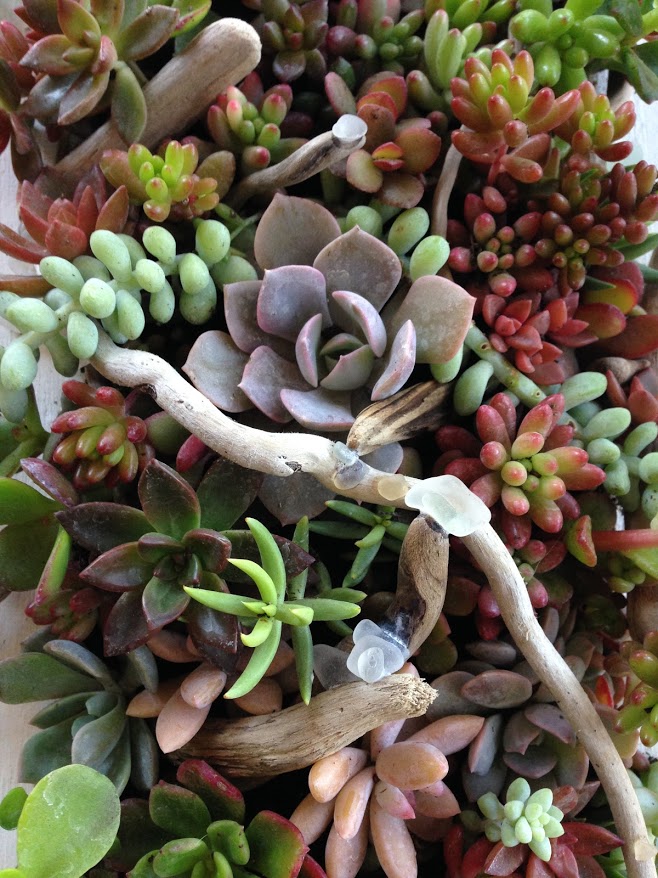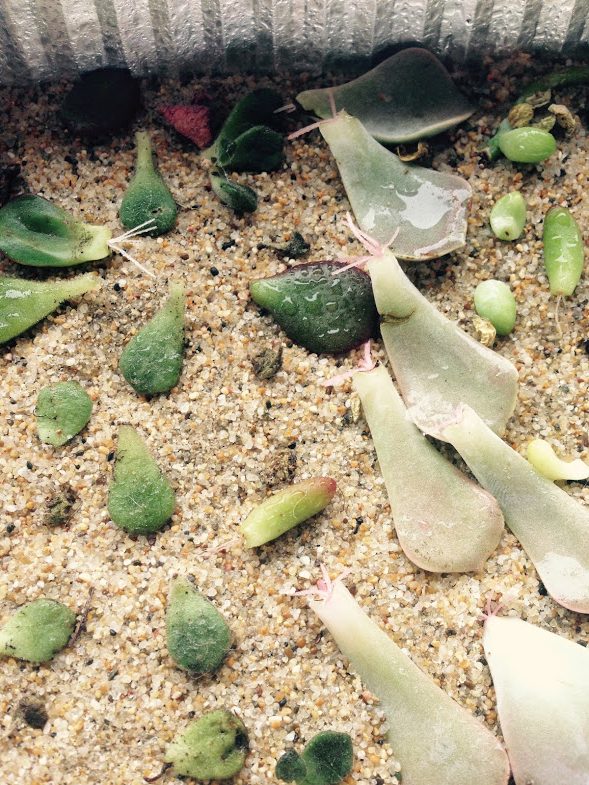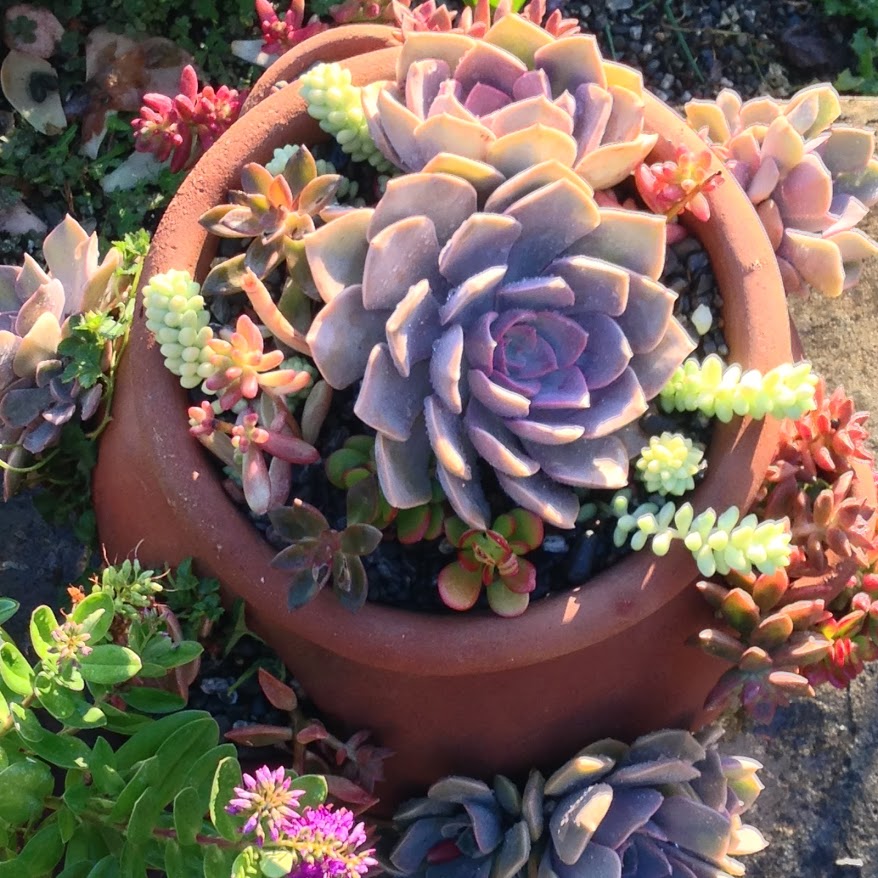by Amy
History of Succulents
In botany, succulent plants, also known as succulents, are plants with parts that are thickened, fleshy, and engorged, usually to retain water in arid climates or soil conditions. It is a characteristic that is not used scientifically for the definition of most families and genera of plants because it often can be used as an accurate characteristic only at the single species level. The word succulent comes from the Latin word sucus, meaning ‘juice’, or ‘sap’. Succulent plants may store water in various structures, such as leaves and stems. Some definitions also include roots, thus geophytes that survive unfavorable periods by dying back to underground storage organs may be regarded as succulents. In horticultural use, the term succulent is sometimes used in a way that excludes plants that botanists would regard as succulents, such as cacti. Succulents are often grown as ornamental plants because of their striking and unusual appearance, as well as their ability to thrive with relatively minimal care.
How to Grow Succulents from Cuttings

Growing Succulent Cuttings
There are many ways to grow succulents. Succulents can be grown from seeds, leaves, stems, or cuttings. In this article I will be focusing on cuttings.
Growing succulents from cuttings requires a few steps:
- Selecting Great Redwood coastal design Cuttings
- getting cuttings to callus
- popping roots
- Planting in sandy well draining soil
- Watering with a mister
- lightly fertilizing
- enjoy
- taking cuttings to expand your garden
Selecting the Cuttings
Its important to start with great organic succulent cuttings. They can be purchased from redwood coastal design which guarantees quality cuttings. The other option would be anywhere you trust to bring clean bug and disease free cuttings into your space. One sick cutting can quickly spread throughout your garden or indoor plants. If your unsure about the cleanliness of your cuttings they can be rinsed and dried before bringing into your space.
Getting Cuttings to Callus
If the cuttings were purchased from redwood coastal design they can be placed directly into the soil the cuttings have already been allowed to callus. Normally 3-5 days of not watering the cuttings will cause the succulent to callus up. This speeds up root development and keeps bacteria and disease from entering the wound. A cutting will normally root without callusing, but the plant may not develop as quickly.
Soil
Succulents need well draining soil. Choose an organic soil that is specifically made for cacti and succulents. Sandy mixes work best and are available at most home and garden stores.
Watering
After cuttings callus slightly they are ready to water. Try not to over water misting with a spray bottle a couple times a week should be fine. Succulents don’t require very much water especially in the winter. Overwatering is the most common way to kill a succulent.
Fertilizing
Choose an organic fertilizer that is specifically made for cacti and succulents. Make sure fertilizer contains nitrogen, phosphorus, and potassium . Divide the recommended dose by half and add the fertilizer to the watering can.
Take Cuttings To expand your Succulent Garden
Once your succulents are growing and looking healthy they will quickly outgrow their container. At this point you can take cuttings and follow the process above to expand your succulent garden or give some to a friend. With the proper care and attention your succulent garden could live on for many many years.
Sunlight
Do not expose the newly planted succulents to direct sunlight. Wait until the roots are established before you transfer the plants outside to the garden beds or containers. After the succulents are rooted firmly in their soil they require 3-5 hours of direct sunlight daily.

How long do Succulents take to Root
Succulents can take four to six weeks to start growing roots. Many things can effect the length of time they take to grow roots and fend for themselves. Sunlight, temperature, and moisture are the most important. Indirect sunlight with a temperature between 65-75 is ideal. Misting once or twice a week should provide enough water to get the roots going.
How to care for Succulents
One of the most important requirements for your succulent is sunlight. Succulents need at least 4-6 hours of sunlight exposure every day. However, too much of the sun can harm them. During the summer, it is very important to provide shade for the plants. Too little light, on the other hand, is also very bad. A partial shady area on the west side of the house is ideal. Indoor succulents often suffer from having not enough light, especially during winter. A light placed near the indoor succulent will help keep it healthy during the low light winter months.
Apart from light, succulents also need water. But again, not too much of it. Succulents don’t like overwatering. In fact, it can kill them. So when watering succulents, it is very important to soak the soil and let it dry out before watering again. The amount and watering frequency are also dependent on many factors. The climate and immediate environments are some of them. During summer, for instance, succulents need more water than during winter. On hotter days, succulents need water at least once a week. Outdoor succulents may need more water than the indoor ones. This is because they are exposed to dry air that speeds up the drying process of the soil.
